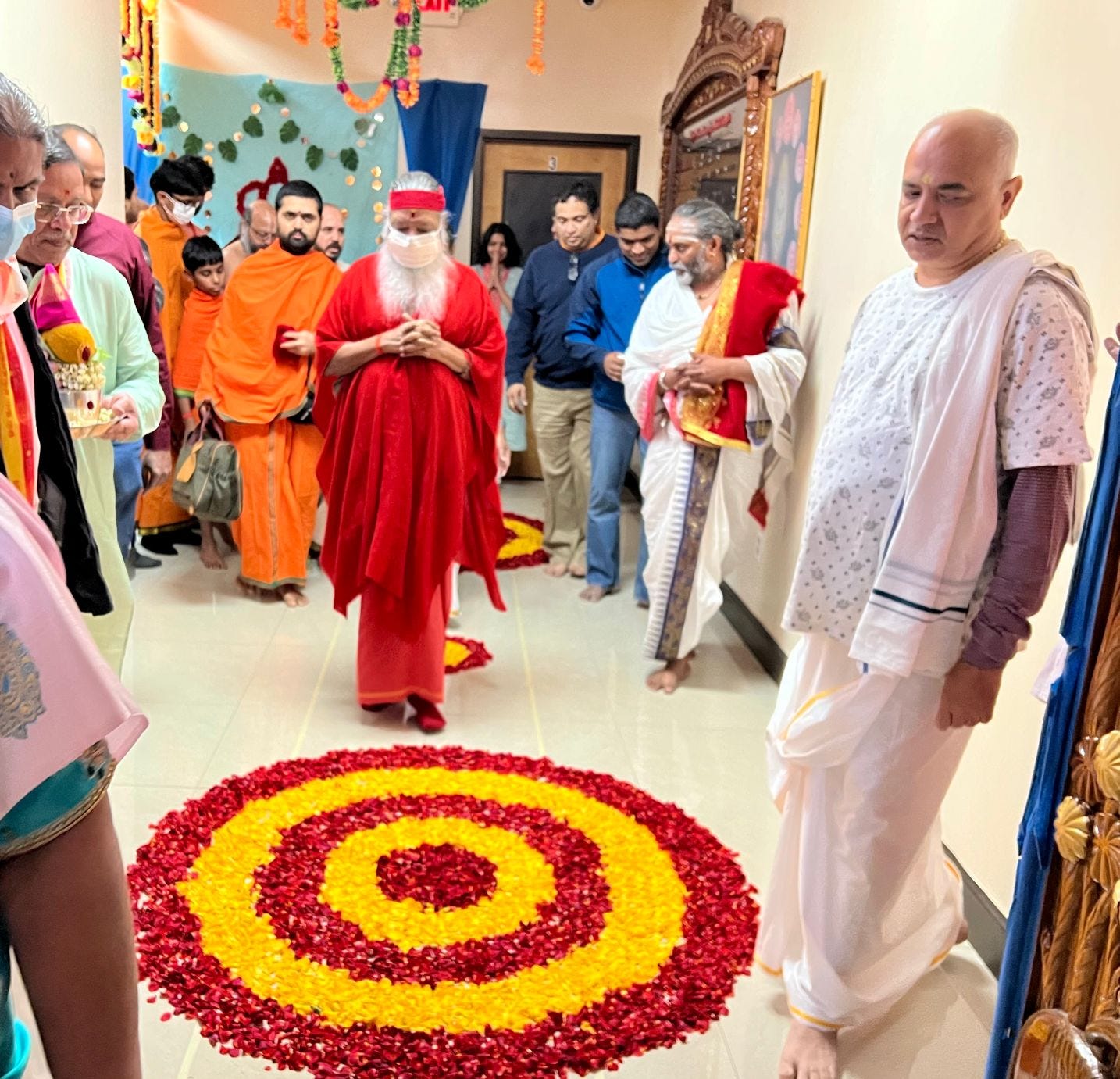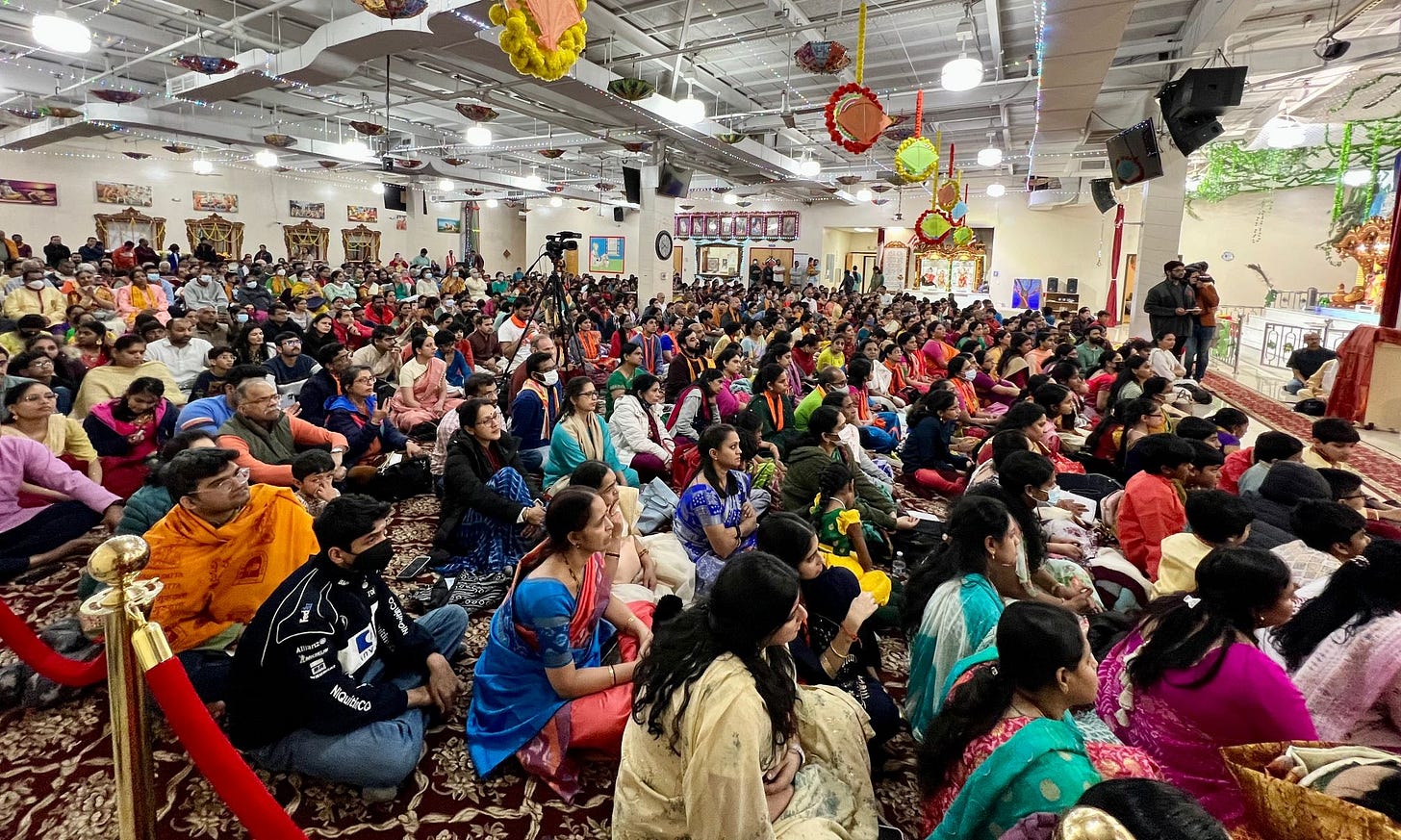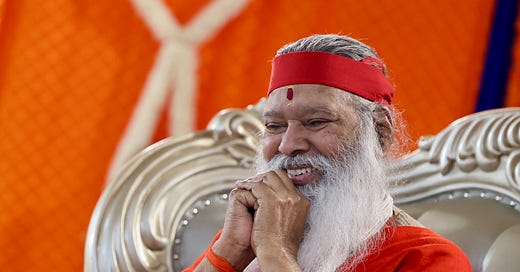On Tuesday, March 28, I hopped in my family friend’s rental car and drove from New York City to Monmouth Junction, New Jersey, to see my guru, Sri Ganapathy Sachidananda Swamiji, and chant the twelfth chapter of the Bhagavad Gita. It was my first time going to see my guru without any of my family members present, and it felt more than a little odd. Going to see my guru turns into a kind of family reunion where we get to see all of the other devotees, many of whom have become honorary family members over the years. They are the uncles and aunties who host us in their homes when Swamiji visits their city, the cousins who entertain the young kids while their parents pray, and the siblings who were my playmates in ashrams across the United States. With so many connections, I usually rely on my parents to remind me of everyone’s names and what’s been happening in their lives (”Where does their kid go to college?” “Did he get his work visa?” “Should I ask where her husband is?”). I desperately wanted a Devil Wears Prada-style book with everyone’s names, photos, and important information. Luckily, I was going with a family friend who was very close to my parents, Chaitu Ana, and I knew he would help me avoid embarrassing interactions. I was also excited to meet my Bhagavad Gita teacher and mentors who I had never seen in-person before.
As we traded the skyscrapers and cacophony of the city for the tree-lined New Jersey suburbs, I thought about the incongruities between our surroundings and our purpose for gathering together. Dressed in my salwar, I felt out of place amongst the manicured lawns and Ford F-150s of American suburbia. It was as though I were suddenly a foreigner in my own country. Then, as always happens on trips to see my guru, the status quo switched as we drove into a suburb primarily filled with Indian families. We laughed as we saw a yellow school bus unload three children, all of whom were Asian, and noticed shoes carefully laid outside the door of nearly every house we passed. We entered a garage filled with the smell of sticky gulab jamun and comforting sambar, and I waited for Chaitu Ana to drop off some supplies for my guru, who was staying with a local family.
The places my guru chooses to visit in the United States can seem random. Instead of going to New York, Sri Swamiji will go to Edison or Monmouth Junction, New Jersey. He’ll stop in Baton Rouge and Chicago, but also Newburgh, Indiana. Instead of reflecting places with spiritual or cultural significance, His itinerary highlights the centers of immigration for His devotees. For many Indians, the decision of where to live in the United States comes down to where family and friends have already settled, and this in turn influences where temples are established. When my mom came to the United States as a child, her family first moved into her aunt and uncle’s house in Texas. They then eventually came to settle in Newburgh, Indiana, where a number of other South Indian families lived and where others soon followed. My grandparents lived there for most of my childhood, and as early devotees, they would sometimes host Sri Swamiji in their home. This was a huge honor, and also a service to the other Indian families. Devotees in the area could gather and see our guru, receiving blessings and getting the chance to have a spiritual connection thousands of miles from the holy sites of their native country. Many of these devotees were on strict visas and couldn’t return to India. For Hindus, our spirituality is heavily tied to physical places and objects. The Ganga River is not just the lifeblood to communities, but a spiritual place of cleansing, despite the immense pollution. People travel for days on painfully slow trains to reach holy sites like the Venkateswara temple in Tirupati. While we can pray to photos of our guru and construct shrines in our homes, it does not compare to the blessings we receive by touching His feet or praying to a crystal Shivalingam. For the devotees who left India, they don’t just lose physical contact with their families, but a tangible connection with God. Getting to see Swamiji and offer prayers at His feet is an immense spiritual gift, and a homecoming as well. That is why I was excited to drive an hour out into a New Jersey suburb on a Tuesday. That is why, though I had never been there before, it felt like going home.
At the Shree Swaminarayanan Hindu Temple, I slipped off my Adidas and stepped into a hall full of comforting sounds and smells: children’s feet pattering, adults shushing, bells ringing, incense, camphor, fresh flowers. I caught up with the usual roster of aunties, uncles, cousins, and friends before settling down at the front of the hall. As we waited for Sri Swamiji to arrive, a couple women led us all in singing Hanuman Chalisa, a bhajan praising the God Hanuman. It’s one of my favorite melodies, and I’ve sung it a lot at the Karya Siddhi Hanuman temple in Frisco, Texas, where my grandparents now live. I took a quick recording to give you some idea of what it’s like to sing in a room full of devotees, sitting cross-legged on the ground as children run past, scampering after one another while their weary parents look on. It’s an immensely warm feeling, as though you aren’t just one person, but part of a collective voice and sound.
Recording of Hanuman Chalisa at Shree Swaminarayanan Hindu Temple in Monmouth Junction, NJ
Then, it was time for Sri Swamiji to arrive. Since Chaitu Ana was helping to coordinate His visit, he tipped me off to when Sri Swamiji would get there and pushed me up to the front of the crowd, like I was any of the other small children whose parents shoved them to the front. I was grateful he did, though, because Sri Swamiji, my guru who had named me and knew me from my infancy, saw me and broke out in a smile so warm, it melted away the stress and worries I carried with me that day. I also got to speak to Prasadi Ana, who told me that he has been enjoying this blog and to keep it up (hope you’re enjoying this one too!). After receiving offerings from the New Jersey families, Sri Swamiji gave his discourse. These speeches are mostly in Telugu with some English thrown in and can be about anything. However, they typically center around the topic of how to lead a fulfilling and spiritually-centered life. In this speech, Swamiji spoke about the current project being undertaken to build an ashram in New Jersey, similar to the ones in Frisco and Pittsburgh. He said that He visited the proposed site and was very happy with it. Now, it was up to the devotees to create a space where people could receive spiritual education and connection.

The other main point of the speech, which I gleaned from the English segments and the translations that people posted in the comments of the Facebook live stream, was that people expect too much from their religious offerings. He spoke about how devotees will make offerings of flowers or money, and then expect 100% of their problems to be solved and all of the good karma to flow to them. But how is this possible when their actions and thoughts are not 100% pure or devoted? Much of our lives is spent doing things that are not thoughtful, devoted, and selfless. Yes, I may donate to charities, chant the Bhagavad Gita, and eat some healthy dinners. But I also stay out late with my friends, skip Bhagavad Gita classes, and, from time to time, think unkind thoughts about people around me. It’s not necessarily our fault, Swamiji said, as humans possess a doubting and fickle nature, but we can strive to be better. He also spoke about how often we worry about things that are outside of our control (election results, economic conditions, how others think of us), but so rarely do we take actions that focus on bettering ourselves. If we cultivated a healthy, calm, and compassionate space within ourselves, wouldn’t that make us strong enough to affect positive change in our communities? Wouldn’t the people in the wider world benefit from our self-work? I hear a lot of popular wellness talk use phrases like “manifesting” and “self-care” in conjunction with the co-opting of Eastern spiritual practices. The wellness industry wields these phrases with a showman’s disregard for real healing or compassion, using them to sell turmeric supplements and CBD tulsi tea. Instead of investing in the kind of meditative and long-term work that results in true self-actualization, companies try to sell products as a get-enlightened-quick scheme. These supposed “solutions” entrap us in cycles of consumption rather than liberate us with sustainable ways of being. Sri Swamiji’s speech was an important reminder that cultivating practices that require patience and restraint, like chanting the Bhagavad Gita, are worthy pursuits that have endless benefits for ourselves and those around us.

With that speech still echoing through my mind, we then proceeded to chant the twelfth chapter of the Bhagavad Gita. Why the twelfth? It is the first chapter that readers and memorizers learn because it is one of the shortest and least difficult in terms of pronunciation. Therefore, it’s the one that most people in the temple knew. I had never chanted in a room with that many people before, and I had wondered all day what it would feel like. I was so used to just hearing my own voice on Zoom calls. When the chanting started, I was shocked at how the soft lilting of my voice became subsumed into the sound of hundreds of people chanting as one. It reminded me of those scenes in Avatar: the Last Airbender when Aang speaks with the voice of all of his previous lives while in the Avatar State. You can sort of hear individual voices, but it mostly becomes this other-worldly drone that exists outside of time. The video recording I got on my iPhone doesn’t do it justice, but it’s a quick peek into that experience. You can hear me start to chant in a slightly different tune before I’m able to properly hear myself and blend my voice into the rest of the chorus:
Recording of the twelfth chapter of Bhagavad Gita being chanted at Shree Swaminarayanan Hindu Temple in Monmouth Junction, NJ
At the end of the night, I had the privilege of receiving my guru’s blessings in the form of a necklace and small raksha to tie around my wrist. We then got ready to leave, but not before Chaitu Ana was subjected to the oldest of all Hindu temple traditions: having your shoes go missing. Since everyone must take off their shoes before entering a temple, sometimes a pair of shoes will just… get up and walk away. This is typically why my family and I wear our dollar store flip-flops to temple. Unfortunately, we lost a good pair of Allbirds that day, and Chaitu Anu drove us home barefoot (but shhh don’t tell anyone).
I wanted to tell Sri Swamiji that I was learning the Bhagavad Gita like He asked me to do, but I never got the chance. It was nearly 10:30 pm by the time He greeted all the devotees who were there, and He had an early flight to Trinidad the next day, so I didn’t want to take up His time. I like to think that Sri Swamiji knows and is pleased with my efforts to learn the Bhagavad Gita, but of course, I have no real way of knowing. Instead, I have to take it on faith and not give into my doubtful human nature. I have to believe that even on days when I am frustrated by my lack of progress or the many mistakes I make while chanting, my commitment to a spiritual practice is worthwhile. I may not get 100% of the things I pray for, and I may not wake up one day to find myself magically enlightened. Instead, I will create a space within myself that is patient; a place that is fertile enough to sustain long-term personal growth. It is there that I can remember the power of hundreds of voices chanting as one. It is there that I can remember what it feels like to return home.






Vahni thank you for taking me to Sri Swamiji through your lovely and evocative passage of your moments in his presence!
Amma Karunamayi is Edison New Jersey this week. She is a great Avatar from Andra Pradesh much smaller scene. Highly recommend getting her blessings.